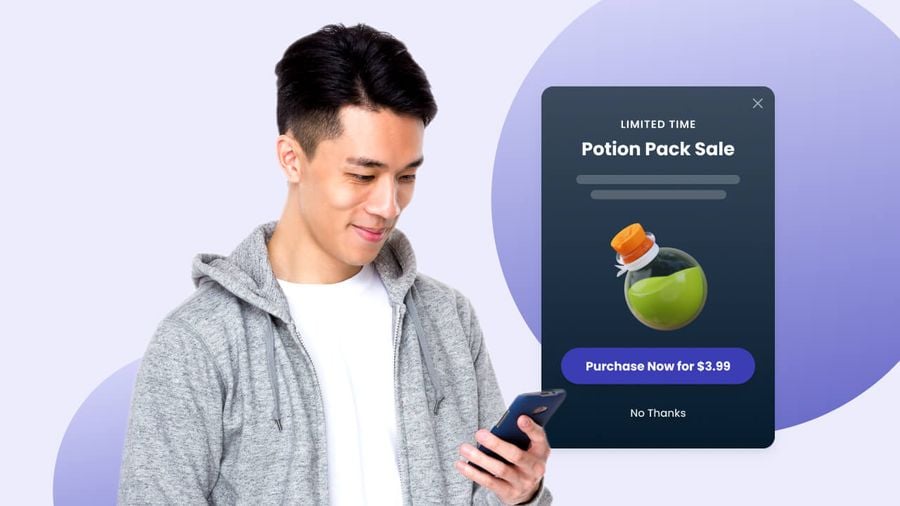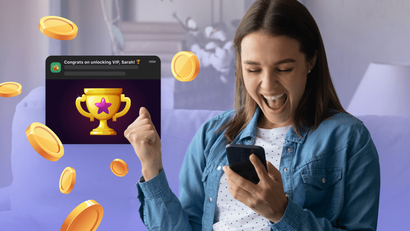What is app monetization?
App monetization is a strategy whereby app developers generate revenue from their app user base. Most app monetization strategies are designed for free applications. In other words, the vast majority of apps don’t charge for downloading the app itself. App monetization strategies include subscription models, advertisements, in-app purchases, and more. Many monetization models aim to convert a small segment of users into paid customers to fuel sustainable business growth.
Today, users are more willing than ever to engage and respond to monetization. The mobile app marketplace is expected to reach $935 billion in revenue in 2023. In 2022 alone, consumer spending on mobile apps reached a record $33 billion.
How do you choose an app monetization strategy?
Choosing the best app monetization strategy is like selecting a pair of shoes. Although there are many highly effective and powerful strategies, what works best is what’s right for you. Identifying the correct monetization model means thinking about what makes sense within your user experience. Do in-app purchases complement your UX? Do you have advanced features or services that you could package into a premium subscription? Before you choose a new monetization model, make sure that your product roadmap aligns with your proposed offering.
Below are five of the most powerful app monetization strategies used today.
5 Strong App Monetization Models to Consider
1. Paid App Model
The paid app model is the oldest and most straightforward way to monetize your app. This model charges an upfront, immediate fee at the time of installation and generates a revenue stream directly proportional to the number of downloads. Apps such as Heads Up! ($0.99, App Store) and WolframAlpha ($2.99, App Store) are two successful examples of the paid app model.
Strategic pricing and powerful features are critical characteristics for successfully executing this strategy. Although the paid app model has been shown to generate increased user engagement and loyalty in the short term (people are generally more likely to use something they’ve paid for), only about three percent of apps use this strategy today. Attempting to convert users into paid customers before they’ve had a chance to use your app and understand its value is a hard sell unless you already have widespread brand recognition and demand. In general, free apps tend to be more profitable than paid apps.
2. Free & Paid App Model
Alternatively, many developers solve the challenge above by developing two separate versions of their app: one freely available to download and one premium subscription version. The rationale behind this model is to remove the initial price barrier to entry and allow users to try out a shortened, free version of the app with limited features.
The free-and-paid monetization model sells the app's value proposition and allows the user to reach a point where they feel compelled to purchase the premium version to access additional features.
Mobile game companies often follow this model. One of the most successful examples from the early 2010s was Geometry Dash ($1.99) & Geometry Dash Lite (FREE).
3. In-App Purchases Model
This strategy is one of the most popular app monetization models used today. This model lets users spend real money to earn some sort of upgrade in the app itself. Adding purchasable items such as features, accessories, services, or content can greatly increase customer engagement and generate revenue. In 2021 alone, users worldwide spent over $380 billion on in-app purchases.
While in-app purchases go a long way to improve the user experience, not all users are willing to pay more, especially if they have already paid an upfront fee. If you use this strategy, avoid overwhelming users with too many in-app purchase requests or paywall barriers that can drive them away from the app.
For many apps, converting as little as five percent of active users can equate to significant growth and long-term revenue gains. In-app purchases are most effective when they’re highly targeted at specific user segments and personalized to fit their preferences and user journey. Many apps leverage in-app messages and push notifications to create promotions and time the upsell based on specific user engagement triggers. For instance, a gaming app that offers in-app avatar accessories for purchase might send an in-app message to a user with a free app store coupon after they complete the first game level. Other apps target promotions exclusively at high-spending or highly-engaged users who are more likely to convert based on these characteristics.
4. Free App with Subscription Model
The “freemium” subscription model has become increasingly popular over the past few years. Apps such as Netflix are notorious for their free-to-download, subscribe-to-use model. In fact, by the end of 2022, over 53 percent of all software companies will transition to subscription models. The power of subscription models lies in the fact that you can create different purchasing plans for different user segments. Unlike the free and paid app model, the freemium subscription model creates a reliable source of recurring revenue which relies more heavily on user retention than user acquisition.
Variety comes into play when looking at price, length of time, and features purchased. Subscription models are often divided into tiers, with each tier paying more or less based on the number of features or content that’s accessible. Because subscription models work on a recurring payment basis, it’s up to the app developer as to what interval users are charged. Consumer psychology plays into that decision as well, as slight discounts for annual subscriptions can encourage more long-term commitments.
With any subscription model, the cost must be commensurate with the offering at each level. Many apps launch as a free product and transition to a subscription model after building their user base and demonstrating proof of concept. Good communication is imperative if you plan to switch from a free app to a subscription model or want to adjust the price of subscriptions over time. Unlike other monetization models, managing subscriptions require ongoing relationship maintenance and expectation setting. It’s considered best practice to proactively communicate with users when their subscription is about to end, renew, or change in any way (in price or content). For apps, that communication can take place via in-app messages, push notifications, or email.
5. Free With Ads Model
The free-with-ads model generates revenue by displaying advertisements to users within the app. These advertisements can passively exist inside the app or actively engage with the user to unlock rewards or features. Social media giants such as Facebook, Snapchat, Instagram, and Twitter are big users of the free-with-ads model.
Targeted digital advertising has drastically changed the landscape of the marketing world. Although Google’s third-party cookie ban is reshaping digital advertising, mobile app advertising is still a lucrative industry. Mobile app ad spending continued to rise in 2021 despite COVID and industry changes, and global mobile app ad revenue is expected to reach $935 billion in 2023 — a $353 billion increase from 2020.
Some apps employ a free-with-ads monetization model alongside a subscription model. In such instances, the free app includes ads, and the premium app is ad-free. This model generates revenue from free and paid users and makes an ad-free experience a key incentive to upgrade.
The biggest challenge with this monetization model is that it has the potential to disrupt and damage the user experience. For this model to work well, the app experience must be positive and valuable enough to warrant the customer putting up with ads or paying money to upgrade. User expectations for in-app ads can vary between app categories and shift based on the competition. If other comparable ad-free apps are available, chances are you’ll have to bring something else to the table (more advanced features, a better UI) to make your product compelling with ads. In addition, it’s essential to consider the frequency and form (full-screen, banner, pop-up) of ads you implement because these variables can impact the user experience.
Using Messaging Tools to Drive Revenue
Creating a user messaging strategy alongside your monetization strategy can drastically improve app engagement and revenue. Understanding when and where users lose interest or fail to convert is critical to optimizing monetization. The best way to gather these insights is through customer messaging, especially at critical junctures in the user journey.
An effective messaging strategy can generate higher conversion rates, especially for free-to-paid and subscription models, by alleviating friction and offering users convenient solutions or rewards. Additionally, customer messaging can pay long-term dividends in the form of better overall customer engagement and retention.
Push Notifications
Push notifications are a powerful monetization tool. First and foremost, they give app companies the power to communicate with their users even after they’ve left the app. Bringing users back to your app and building loyalty directly impacts in-app purchases, subscriptions, and ad revenue. In the free-with-ads model, more engagement with notifications ultimately equates to more ad engagement and revenue.
The National Rugby League (NRL) app experienced unprecedented growth and engagement in 2017 when it implemented push notifications to update users on kickoff times, share live match scores, and provide real-time match updates. Rugby fans became more engaged with the league, and monthly active users (MAU) increased to over one million. For the NRL, a more engaged fanbase generates more ticket purchases and merchandise sales.
In-App Messages
Whereas push notifications help reach users after they leave an app, in-app messages provide a direct line of communication with users while they’re actively engaged. It’s no surprise that the click-through rate (CTR) of in-app messages is 25 to 30 times higher than that of push notifications. In-app messages are a powerful monetization tool for driving in-app purchases, subscriptions, ad traffic, and upgrades.
Many mobile game companies leverage in-app messages to their advantage. For example, imagine a game in which a player needs 10 tokens to unlock a new game level. After the player earns their fifth token, they could receive an in-app message offering the option to acquire extra tokens by purchasing them or watching a short ad to expedite their advancement in the game. These types of messages both contribute to the app monetization strategy and encourage game engagement.
Get Started with OneSignal
OneSignal is designed to help you send notifications and in-app messages on iOS, Android, and countless other devices. Our platform is quick to set up and makes it easy to send custom messages without doing any development work. If you don't have a OneSignal account, you can create one for free and start driving revenue today. Don't take our word for it — sign up and see for yourself!
Create a Free Account



